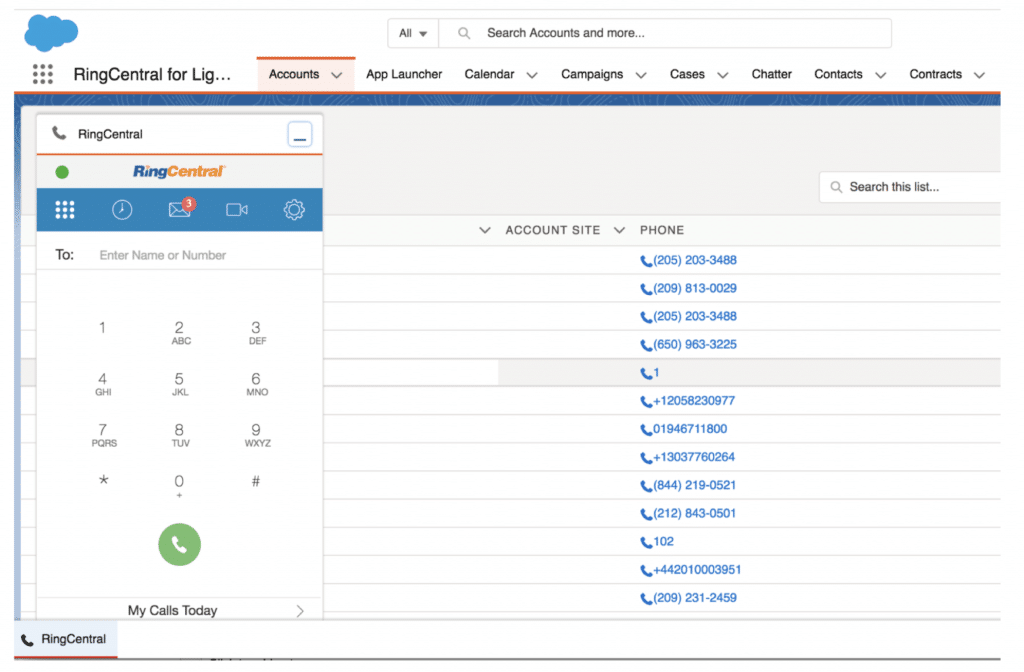Every business should deliver good customer service. Most of them probably think they’re doing a decent job of it.
But what’s your company’s definition of “good” anyway? And more importantly, is it the same as your customers’ idea of what “good customer service” means?
Actually, depending on the industry your business is in, you might have an especially hard time providing service that your customers consider “good”:

Meanwhile, it’s well-documented that consumers will gladly bounce to a competitor if they have a crummy experience.
So, how can you provide stellar customer service (that keeps your customer retention rate at a healthy clip)?
Below, we’ll break down exactly how to level up your business to provide outstanding customer service:
⭐️⭐️⭐️⭐️⭐️ Ready to offer 5-star customer service? Get strategies for every stage of the customer journey with this free eBook.
What is “good” customer service, anyway?
What “good” service means is obviously going to vary from business to business.
For example, factors such as your industry, team size, and tech stack all impact what your support looks like in practice.
That said, there are five core principles of good customer service that every company should adopt.
1. Good customer service is timely
First thing’s first, good customer service starts with a swift response.
Unfortunately, recent consumer research says that the average customer is overwhelmingly annoyed with excessive wait times. In fact, waiting too long on hold is the top complaint for people calling a company’s customer service line:

People want to be served quickly. They also want to be acknowledged by someone as soon as they submit a ticket.
Many customer service headaches can be avoided outright simply by saying “Hey, we hear you, and we’ll be with you soon!” The longer you keep someone on hold or stuck without a reply, the more their tension and frustration is going to build.
And if you can address concerns ASAP, this can prevent problems with your customers. It is also just good customer service in action:

Takeaways for businesses:
- Acknowledge customer service requests ASAP (think: automated confirmation emails, texts, and social messages are perfect for this).
- Provide specific expectations in terms of how long it’ll take for your support team to reply (think: # in a call queue or a message noting that you’ll respond in # minutes).
- If you have a contact center, reduce your hold times or implement more efficient routing so customers aren’t sitting in a queue forever.
2. Good customer service is flexible
Fact: there’s no “right” or “best” communication channel for customer service.
Here are just a few common customer service methods:
- Phone calls
- Social media
- Video calls and screen sharing
- Live chat
- Self-service portals
- Community forums
- SMS (This T-shirt printing company actually has a pretty genius way of using SMS to communicate with their customers about orders)
To provide good customer service, you have to be flexible.
Check out how companies like Shift manage to make themselves totally available to customers, highlighting frequently asked questions, a live chat option, and a dedicated contact page for email and phone support:
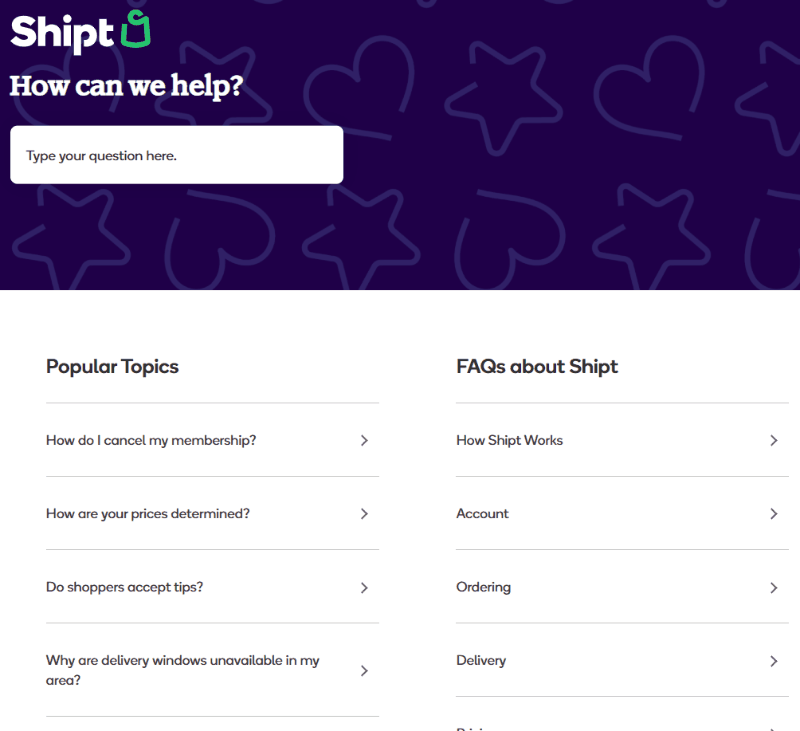
Chances are you have customers that absolutely loathe phone calls. Maybe they’re do-it-yourselfers who’d rather diagnose problems on their own. Alternatively, you probably have customers who need a bit of hand-holding and want to walk through problems step-by-step over the phone.
And that’s fine! Your business should ideally be open to these different channels for customer care.
Takeaways for businesses:
- Don’t treat customer questions as “one-size-fits-all:” explore solutions based on what your customers want versus sticking to a script
- Consolidate your customer support resources in one place on-site so your customers are clearly aware of their options
- Provide resources (think: blog posts, videos, tutorials) for self-service to reduce the need for service calls
3. Good customer service is tailored
Everyone knows to be “friendly” when you’re working in customer service. Smile, nod, make them feel heard… but if you want to really differentiate your business, you need to take that extra step and tailor your service.
Some companies shy away from snark and humor because they think “well our customers wouldn’t like that, they’d hate for us to be so flippant and casual.” And that’s fine—if they’ve done that research or gotten that customer feedback that says they’re indeed correct. But what if your target audience really enjoys memes and slang?
Discord is a great example of a company that speaks their customers’ language, often using slang, sarcasm, and meme-speak to delight their fans:

Think about your own customer interactions when you’re talking to a company. Wouldn’t you rather talk to someone who’s legitimately interested in what you have to say, or someone who sticks to a script with an occasional “Um” or “Ah”?
Takeaways for businesses:
- Talk like a human, not a robot: avoid jargon and corporate-speak when going back-and-forth with customers.
- Don’t be afraid of small talk or getting to know your customer: tailor your interaction to the customer.
- Keep notes on customers in terms of their preferences (think: products, preferred form of contact) to prove you’re legitimately listening to them.
4. Good customer service is comprehensive
Agents should be willing to walk their customers through their concerns to see them through.
In other words, doing much more than pointing someone to a web page or telling them to “turn it off and on again.”
Customer service isn’t something that can be totally templated or mapped out. It’s dynamic.
Let’s say someone wants to move off of a call to a screen-sharing session or they ask you to stay on the line while they troubleshoot their issue. Need to go off script or extend a call to get the job done? So be it.
The willingness to go through these extra hoops is exactly what separates good from mediocre customer service.
Takeaways for businesses:
- Be willing to switch customer service channels (think: from email to phone or screen sharing) based on your customer’s preferences.
- Make sure that agents are familiar with your product or service to answer questions quickly and in greater detail.
- Don’t panic if a customer service call goes “long,” as long as your customer is satisfied.
5. Good customer service is proactive
If you’re only addressing customers’ concerns after the fact, your agents are essentially playing defense.
On the flip side, being proactive by predicting your customers’ concerns—before they snowball—will help you serve them better.
This means conducting outreach and providing resources for your customers to empower them to succeed right from the start.
Customers should also know that they have somewhere to go if they ever do need help. For example, this email from Outdoor Voices is reassuring and signals that their support staff is available at a moment’s notice:
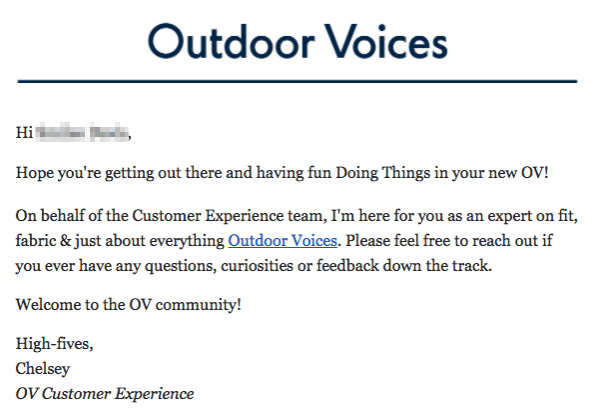
Takeaways for businesses:
- Reach out to customers on a regular basis with check-ins and news to keep the lines of communication open
- Don’t consider a service ticket totally “done” until you’ve followed up with a customer
- Make a point to reach out to customers who’ve gone cold or otherwise haven’t engaged with your product or business within a set period of time (think: # weeks, months, etc.)
10 ways to deliver good customer service
Now that you know what customers want and expect, it’s time to take action.
If you’re trying to figure out how to provide the best customer service, here are 11 strategies to consider.
1. Figure out your most common customer questions and concerns
Not everything related to good service is done in real time.
By preemptively understanding common issues that your customers have, you can create self-serve resources that avoid the need for outreach.
Hone in on these problems by looking at your existing customer support emails and tickets. For example, what are most people calling about? Is there a specific question that comes up all the time?
Check out how Dropbox’s help center promotes “top” articles and tutorials to address common issues:
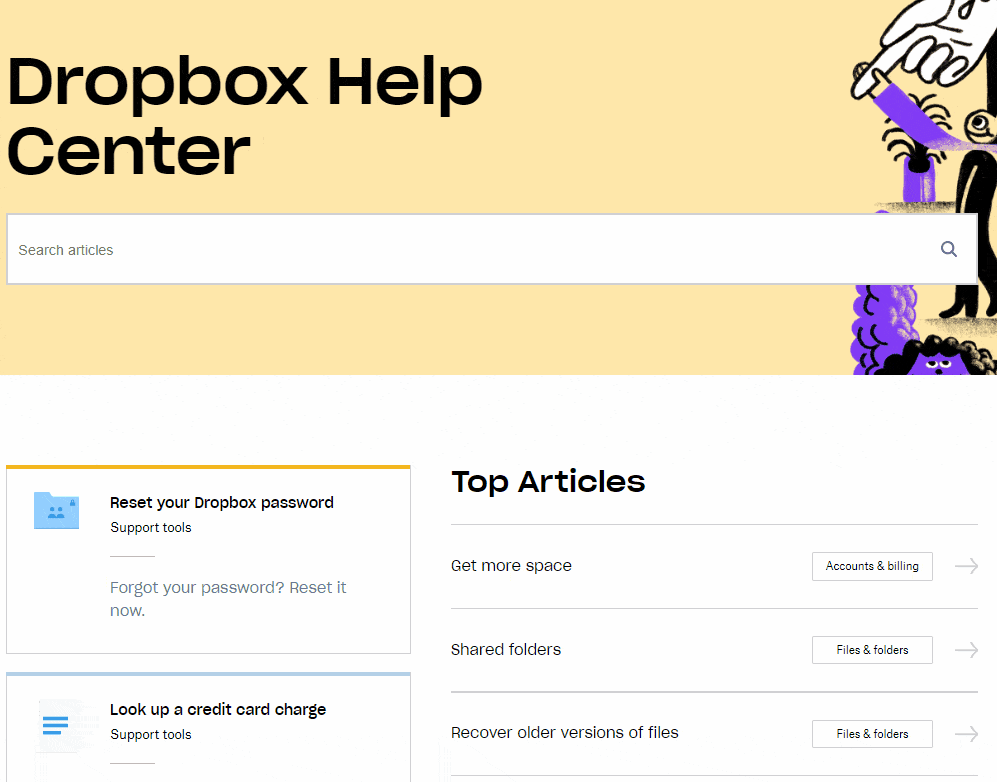
This empowers customers to find answers without having to get in touch—and also frees up your agents’ time. In short, a win-win.
2. Communicate on your customers’ terms and channels of choice
Remember what we said earlier about how many communication channels are available today?
Your customer service delivery needs to be versatile. In turn, agents have to cover a lot of ground and need to be half-a-dozen places at once.
That’s why an omnichannel contact center like RingCentral is a game-changer for busy customer service teams. For example, our platform consolidates all of your digital communication in one place. If you’re receiving queries from social media and email at the same time, you can see them all without leaving RingCentral:
With features like automated routing to agents, you’ll spend less time trying to figure out who to assign tickets to. The platform does the legwork for you.
3. Learn to prioritize your customer service questions
Customers all around the world will hate to hear this: not all customer concerns are the same in terms of importance.
For example, a bank’s support team should obviously prioritize someone who’s dealing with possible ID theft versus someone who has a question about the account they just opened.
If you have details about a customer’s question that’ll impact their immediate well-being, address those first. Not that other customers’ concerns don’t matter, but accepting tickets “in order” doesn’t always make the most sense.
Features in RingCentral such as advanced call forwarding can automate the process of prioritizing customer questions. You can route calls based on criteria like caller ID information, so your most important customers aren’t kept waiting.
4. Personalize your service by logging your customer interactions
When your agents have a detailed customer history front and center, they’re able to provide support that doesn’t make the other person on the phone feel like a stranger.
That’s why having customer service software like a CRM is so important. It lets you log customer-specific notes and get a detailed profile that future teammates can use to provide more personalized customer service.
Want to recommend a relevant product or feature to a customer? Trying to figure out the last time you talked with a customer? With a CRM, there’s no second-guessing. To make your team even quicker on their toes, you can integrate your CRM with a phone service like RingCentral to hop on a call with those customers in real time, right from your computer.
For example, here’s what Salesforce’s integration with RingCentral looks like:
5. Establish customer service standards and expectations for your agents
This is especially important for new hires.
You can’t expect every agent to “get” your business’ concept of good customer service as soon as they’re hired. In fact, you need to be able to define it and communicate it.
Again, how to be great at customer service varies from business to business. As part of your company’s onboarding process, make a point to emphasize:
- Gaining a thorough knowledge of your product (and reference resources to help agents learn)
- The customer service apps that the team uses
- Detailed customer persona(s)
- A style guide that details appropriate language and tone
- Sample customer service situations and processes
- Customer service principles
Taking the time to communicate this to new teammates will ultimately empower them to provide better service—and improve the customer experience overall.
6. Reduce wait times with automated and real-time notifications
As we mentioned earlier, you can’t dawdle if you want to provide exceptional customer service.
That means keeping an eye on your business’ notifications in real-time and following up on them.
Thing is, many support teams are juggling multiple tools and wasting time that they could otherwise be using to solve customers’ problems.
It makes sense to have all of your notifications confined in one place. For example, let’s say you’re using Zendesk’s ticket system and you want to respond immediately to a call. Integrating with RingCentral, you can immediately dial out without having to go bounce to a different platform:
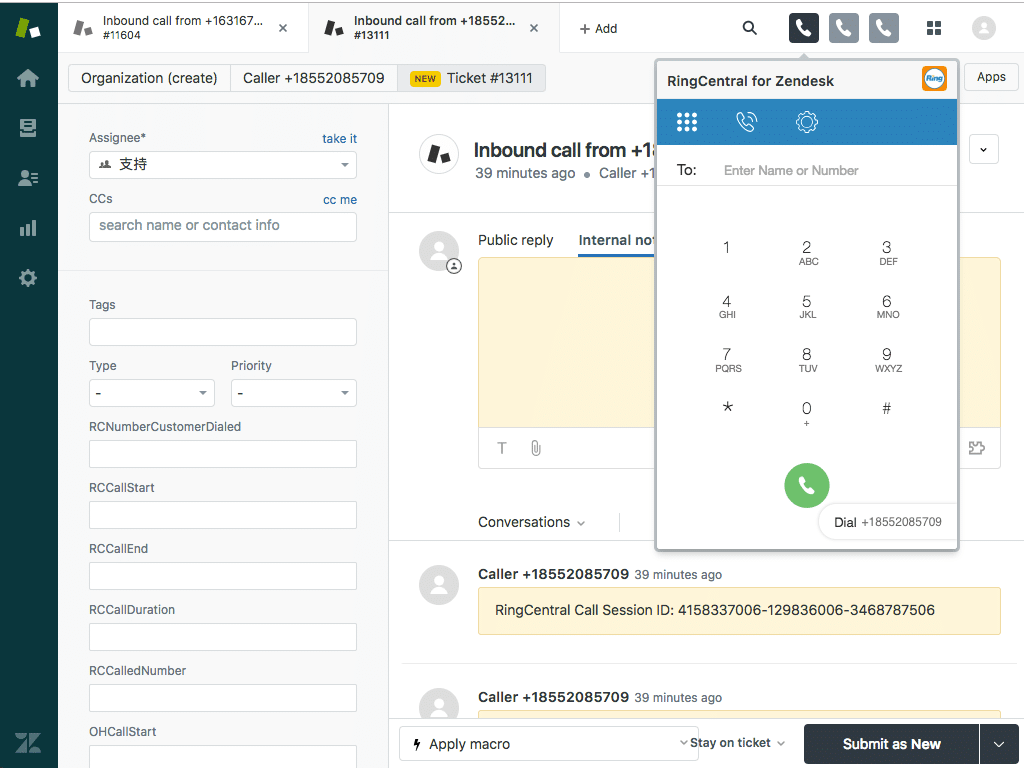
Most major customer service software has built-in integrations like this. Setting up workflow automations and integrations are key to speeding up your service.
7. Talk to your customers—beyond service calls
If you only talk to a company when you’re dealing with problems, you’re eventually going to associate them with headaches.
So, your business should be making a point to reach out before the need for customer service comes up. This can be done in the form of customer surveys, check-in calls, or “just because” discounts and surprises.
Also, consider the importance of following up with customers after a call. Pet brand Chewy is often cited as having the best customer service by customers because they regularly send out personalized follow-ups, gifts, and discounts:
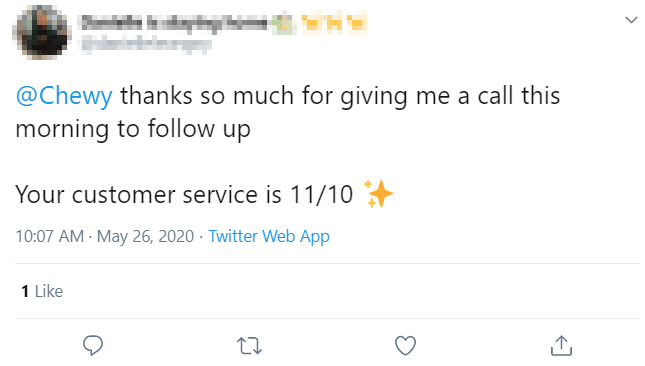
Given that most companies don’t follow through to make sure their service is satisfactory,1 the bar is low to exceed your customers’ expectations. This is a huge window of opportunity for companies to go above and beyond.
8. Don’t shy away from scripts and templates to save time
Much of how to provide agile customer service hinges on your ability to have real-time interactions that delight customers.
That said, there is a time and place to use templates and scripts.
Seems a bit backward, right? Hear us out.
Think of templates and scripts as tools, not crutches. Use them as a jumping off point, something that you can edit on the fly so that you’re not always starting from scratch when talking to a customer.
For example, many social media teams have default replies for questions that then guide customers to a real-life rep. Here’s an example of saved replies in Sprout Social, for reference:
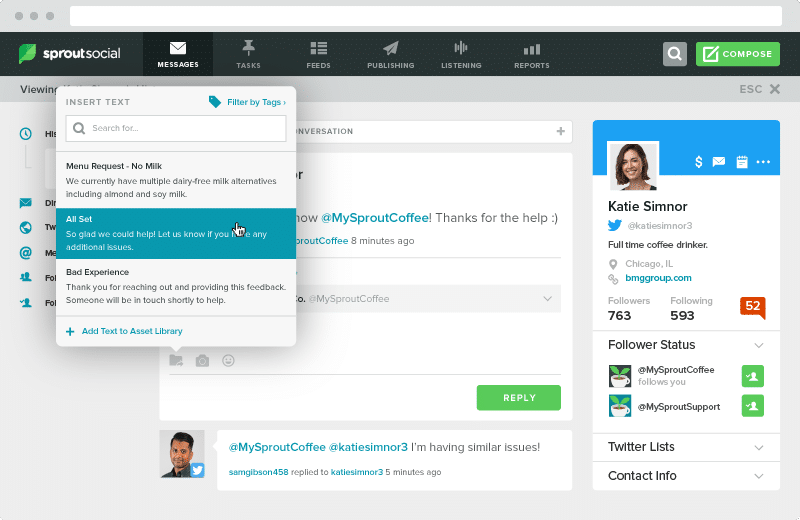
Using scripts and templates also creates a sense of consistency in your service that means agents don’t have to “freestyle” as much. Doing so makes sure that your customers are always routed to the proper channels.
9. Make your customer service a collaborative effort between your team
To be a good customer service agent, it helps if you aren’t an island.
As noted in our guide to customer service teamwork, agents that are empowered to collaborate with teammates tend to have better results than lone wolves. Team knowledge is so valuable. Share it.
10. Actively develop your team’s customer service skills
Learning how to provide excellent customer service is a process that takes time.
Agents need to hone their customer service skills, such as empathy and active listening, as they grow in a team. If there’s a rep who’s struggling or doesn’t have these skills right out of the gate, don’t give up on them.
Provide constructive feedback to reps via meetings and using performance data like customer service KPIs that clue them in on ways to improve. Much like your customers should feel supported, companies need to share that sort of dedication and compassion when it comes to developing their employees’ skills.
Ready to provide good customer service?
Good customer service doesn’t happen by accident.
Expectations are always changing and businesses have to adapt to meet the needs of modern customers. Tools like RingCentral can also do a lot of the heavy lifting to speed up your service and make it more comprehensive.
Stick to the principles and get on the path to providing top-tier customer service.
Originally published Apr 01, 2020, updated Jul 26, 2024


